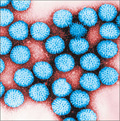Rotavirus is a virus that causes gastroenteritis (inflammation of the stomach and intestines). The rotavirus disease causes severe watery diarrhea, often with vomiting, fever, and abdominal pain. In babies and young children, it can lead to dehydration (loss of body fluids). Rotavirus is the leading cause of severe diarrhea in infants and young children worldwide. Globally, it causes more than a half a million deaths each year in children younger than 5 years of age.
 Symptoms
Symptoms
Rotavirus disease is most common in infants and young children, but adults and older children can also become infected with rotavirus. Once a person has been exposed to rotavirus, it takes about 2 days for symptoms to appear.
Sympvtoms include
- Fever
- Vomiting
- Diarrhea
- Abdominal pain
 Vaccinated and unvaccinated children may develop rotavirus disease more than once because there are many different types of rotavirus and because neither vaccine nor natural infection provides full immunity (protection) from future infections. Usually a person’s first infection with rotavirus causes the most severe symptoms.
Vaccinated and unvaccinated children may develop rotavirus disease more than once because there are many different types of rotavirus and because neither vaccine nor natural infection provides full immunity (protection) from future infections. Usually a person’s first infection with rotavirus causes the most severe symptoms.
Vomiting and watery diarrhea may last from 3 to 8 days in a child who is infected with rotavirus. Additional symptoms include loss of appetite and dehydration (loss of body fluids), which can be especially harmful for infants and young children.
As a consequence of the diarrhoea, skin problems often arise around the nappy area.
Dehydration is the major concern with rotavirus infection, as liquid is lost from the body through diarrhoea and vomiting, and may not be easily replaced.
Signs of dehydration in children include:
- Dry mouth
- Fewer wet nappies or, in older children, not passing urine for six to eight hours.
- Irritable behaviour
- Few or no tears when crying
- Sunken or flatter than usual fontanelles (the soft spots on top of a baby’s head).
- Dry and wrinkled skin.
- Being less alert and active than usual.
- Appearing weak.
- Fast pulse and breathing
Around one in 38 children under the age of five needs hospital treatment for rotavirus gastroenteritis.
In developing countries, where poverty and malnourishment are additional factors, rotavirus gastroenteritis may be responsible for as many as half a million child deaths every year.
Causes and risk factors
Rotavirus is spread through airborne liquid droplets. It can survive for weeks in water and for up to four hours on human skin. It can also survive on surfaces, toys and clothing.
The virus passes into the body through the mouth and nose when liquid droplets are breathed in or when fingers contaminated with the virus enter the mouth.
Rotavirus is highly contagious and most children have had the infection by the time they reach five years old. Children under the age of two are most likely to catch the infection.
The number of rotavirus infections peaks during winter and spring.
Immunity develops after the initial infection, so future infections tend to be less severe. Immunity lasts a long time, which means adults tend not to be affected so badly, if at all.
Treatment and recovery
There’s no specific treatment for rotavirus gastroenteritis.
Ensuring the child takes in enough liquid is essential. Rehydration treatments can be obtained from the pharmacist.
If someone with the infection wants to eat, soups, bread, potatoes and pasta are usually better tolerated. Breastfed and bottle-fed babies and children can continue to be fed as normal.
Paracetamol or ibuprofen suitable for the child’s age can be given to treat fever. Anti-diarrhoea medicines shouldn’t be given to children or babies.
Some children need hospital treatment for dehydration with intravenous fluids.
Prevention
Good hygiene is essential to prevent the virus being spread as the virus can spread easily. This includes:
- Washing hands after using the toilet, handling soiled clothing and linen, changing nappies and cleaning up afterwards.
- Ensuring good hygiene before preparing and eating food.
- Avoiding sharing eating or drinking utensils, towels or face cloths.
- Cleaning toilet, flush handles and seats, and door handles.
- Keeping soiled items away from the rest of the household washing, and using as hot a wash as possible for soiled clothing and linen.
Children with rotavirus gastroenteritis should be kept away from other children until 48 hours after the symptoms have resolved, as the virus can still be spread during this time.
Rotavirus vaccines are very effective in preventing rotavirus gastroenteritis. CDC recommends routine vaccination of infants with either of the two available vaccines:
- RotaTeq® (RV5), which is given in 3 doses at ages 2 months, 4 months, and 6 months; or
- Rotarix® (RV1), which is given in 2 doses at ages 2 months and 4 months
Both rotavirus vaccines are given orally, but they differ in the number of doses given. The vaccines are very effective (85% to 98%) in preventing severe rotavirus disease in infants and young children, including rotavirus infection that requires hospitalization.
Rotavirus vaccines will not prevent diarrhea or vomiting caused by other viruses, but they are very effective against rotavirus infection.
Dr. Jenny Cheriathu John
Specialist
Department of Pediatrics
GMC Hospital

